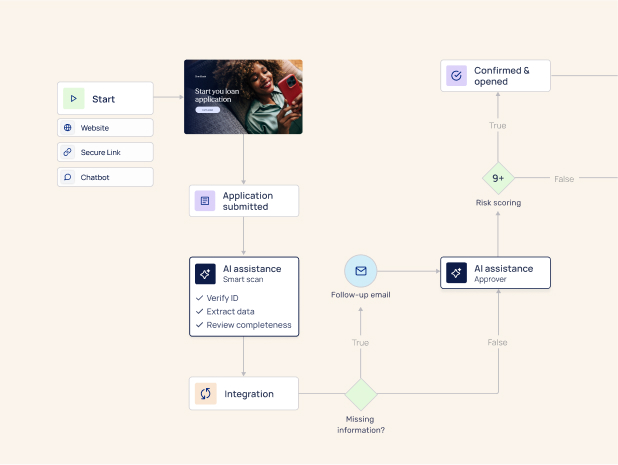Digital transformation doesn't happen overnight. It's a journey that requires careful planning and execution. To succeed, your digital transformation must rest on three pillars that support and reinforce each other to create momentum for your digital transformation: data integration, data intake and customer experience.
- Data integration is the foundation on which digital transformation rests. It is essential for businesses to be able to quickly and easily integrate data from multiple sources to make better decisions, faster.
- Digital data intake is the key to unlocking digital experiences. Collecting data in a digital format enables businesses to make better use of digital technologies, such as artificial intelligence and hyperautomation.
- Digital experience is the key to success with digital transformation. Creating digital experiences that meet customer needs is essential for driving growth.
Let's take a closer look at each of these pillars:
Data integration
[.emph]Data integration is the key to unlocking the value of your data and making it accessible to all parts of the organization.[.emph]
The first pillar is data integration. Data is the lifeblood of digital transformation and integrating disparate data sources is crucial to success.
Data silos are a common issue that companies face. Silos between departments, data formats, and platforms make it difficult to get a holistic view of the customer. This in turn, makes it difficult to provide a seamless digital experience.
Data integration breaks down silos and allows digital transformation to occur. Data integration is the process of combining data from multiple sources into a single, coherent view. This allows businesses to make better decisions, faster. Data integration is the key to breaking down silos and unlocking the insights that digital transformation needs to succeed.
Without data integration, digital transformation is simply not possible.
Digital data intake
The second pillar is digital data intake.
[.emph]Digital data intake is the process of collecting data, documents and signatures from customers. This is crucial for many digital transformation initiatives, such as digital customer onboarding.[.emph]
Relying on manual data intake methods such as paper or PDF forms is a major barrier to digital transformation. Manual data collection processes are slow, error-prone and expensive. They also make it difficult to track customer journeys and understand customer needs.
Digital data intake replaces inefficient manual processes with digital forms that can be completed on any device. This allows businesses to collect data quickly and accurately, while providing a better experience for customers.
Data collected this way is verified at the point of entry, ensuring accuracy and preventing delays. It can then be routed to the appropriate systems and departments for digital transformation initiatives.
Collecting data in a digital format unlocks digital experiences powered by digital technologies, such as artificial intelligence and hyperautomation, which are used to increase efficiency, automate repetitive tasks and provide tailored recommendations.
Digital data intake solutions make digital transformation possible by making it easy to collect data from customers in a digital format that can be easily integrated into your workflows, enabling you to make better decisions, faster.
Digital experience
The third pillar is digital experience. Digital experience is the difference between a digital transformation initiative that fails and one that thrives.
[.emph]A digital experience is an end-to-end customer journey that is designed to meet the needs of the digital customer. It should be simple, seamless, omnichannel, and personalized.[.emph]
To create a holistic digital experience, businesses need to take a customer-centric approach. They need to understand the customer journey and design digital experiences that meet customer needs.
It is also important to design digital experiences that are consistent across all channels. Customers should have consistent brand experience whether they are interacting with your organization via a website, a mobile app, a call center, or in person.
Creating a digital experience is a complex task that requires businesses to rethink their customer journeys and design personalized experiences from scratch. However, the rewards are worth it: digital experiences improve customer satisfaction, increase loyalty, and drive growth.
.avif)
The key is in the digital data
Digital transformation is a journey, not a destination. There is no “end state” for digital transformation, it is an ongoing process that businesses need to commit to if they want to stay ahead of the competition.
Data is the key to success with digital transformation. It is the foundation that all digital transformation initiatives are built on. The three pillars of digital transformation – data integration, digital data intake and digital experience – are the foundation that digital transformation initiatives need to succeed. Without all three, digital transformation will fail. With all three, digital transformation can thrive.
How to get started with digital transformation?
The key to success is to start small and scale up. Begin with a digital transformation initiative that will have the biggest impact on your business and build from there.
As you scale up, you will need to invest in all three pillars of digital transformation: data integration, digital data intake and digital experience. These investments will help you create momentum for your digital transformation and drive growth.
.avif)




